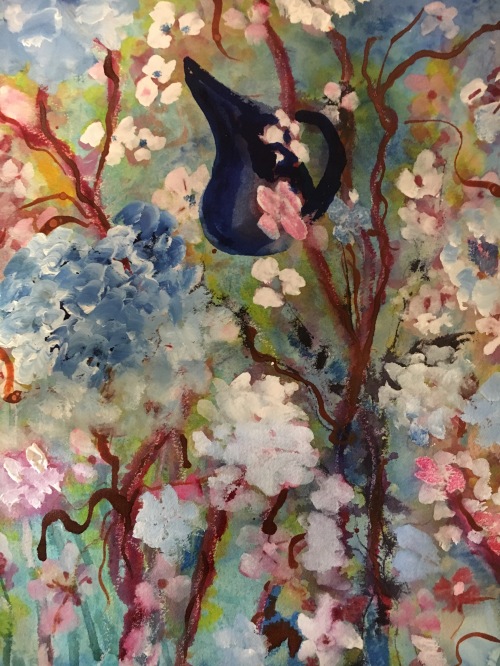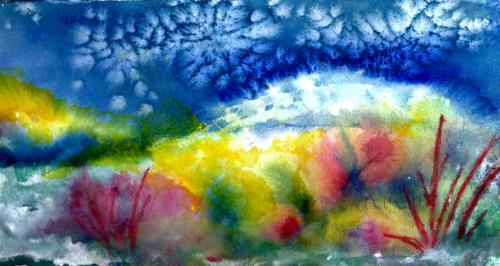
It is often said that artists can create the world the way they wish it would be! This may be true of most of the arts, and many crafts as well—where one is fashioning beauty from ashes—or victory in the midst of something that seems like defeat. In my poetry, I have often featured the presence of light in apparently dark circumstances.
Without getting more ponderous, when indeed my mood is upbeat as I share with you, the above painting is the world the way I’m eager to experience it—and will in a few weeks. Having lived in Wisconsin for all but three of my eighty-four years, I should know (and do!) that April in my home state is not like “April in Paris”.
Sometimes we get teased a bit with warm splashes, and these are meant to be savored but not viewed as the permanent seasonal weather change. Meanwhile, we can paint (sing, write, dance) whatever weather we want—thereby creating our own reality: our own private world. A case in point is this painting, titled “Ice Tea Again”, reflecting a pastime which is HUGE in my estimation: drinking ice tea on our patio beside our pretty little patio garden, while watching the birds and chipmunks that enjoy the hospitality of our feeders.
I have done many ice tea type paintings, but this one is unique. Were you to actually see the painting, now framed in a 16″ by 20″ softly gilded frame, you would probably observe that something new has been added: touches of mixed medium accents which add texture and individuality to the piece.
At this moment two amazing British artists—Ann Blockley and Soraya French—are vitalizing, coaching, and inspiring me via books and (in Ann’s case) DVDs to experiment with mixed media. So “extras” have been added to this watercolor and gouache rendering, including areas of enhanced color on and around the flower shapes made with hard pastel pencils and Derwent Inktense sticks. The winding vines were formed by streaking India ink from a pipette and letting it ooze around on the damp paper. You may notice the sketchy lines drawn by oil pastels* in areas alongside the vines. And, as always, thick applications of gouache have covered a plethora of boo-boos.
The above-mentioned artists, and many others, stress the importance of playing with the mediums, learning what they can do and not worrying about the outcome. JUST PLAY! This really appeals to me after a rather dragged out autumn and winter beginning with the loss of my beloved corgi in October and adding a challenging shoulder replacement to the mix. I intend to play, while drinking volumes of ice tea!
Included in the “play”, is the fact that I am diving into water soluble oils. This is happening at my newly acquired hardwood easel. The easel doesn’t work for watercolor painting, as there is not room enough in the bedroom studio to flatten out the surface. But oils can be done on a tilt. While watercolors, gouache, and mixed medium play happens at my dining room studio, oils are slowly drying and developing on the easel.
Margaret L Been — April 14th, 2008
*When I received my order from DICK BLICK of a beautiful, magenta colored wood box of 60 oil pastels (Van Gogh brand) I reverted to childhood. I can’t express the wonder and joy of running my fingers over the surface of these sticks, marveling at the gorgeous color gradations.














